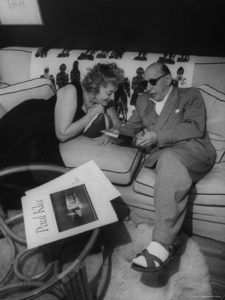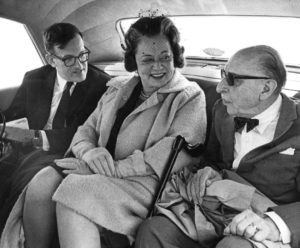
On December 28, 1945, Igor Stravinsky (1882-1971) and his wife Vera (1889-1982) became American citizens. They were sponsored by the actor Edward G. Robinson with whom Stravinsky had been close friends since the 1930s.
The years that followed were among the best of Stravinsky’s life. Despite he and Vera’s shared dislike for the provincialism of Southern California – where they lived – the financial woes that had plagued him his entire adult life became a thing of the past. And while he missed the Russia of his childhood, he found the United States most congenial to his needs, personal and professional. And despite the illnesses that constantly dogged him (as described in yesterday’s Music History Monday post), his life was ordered and peaceful and, for perhaps the first time ever, under his control.

Comfortably ensconced in the U. S. of A., Stravinsky might very well have continued composing neo-classic/neo-tonal-styled music for the rest of his days if not for a young man named Robert Craft (1923-2015).
Craft met Stravinsky in 1948. He was a native New Yorker, a recent graduate of Juilliard, and a total Stravinsky fan-boy. Stravinsky offered him a job as his assistant, and almost overnight Craft became Stravinsky’s right hand: his constant companion, his gofer, his biographer, his artistic advisor, even a surrogate son. But perhaps the most important thing Craft did for Stravinsky was to introduce him to a body of music that Stravinsky had, to now, treated with contempt: the twelve-tone music of Arnold Schoenberg, Alban Berg and Anton Webern, music that Stravinsky had spent the prior 30 years saying was not music at all.

In particular, it was the twelve-tone music of Anton Webern that caught Stravinsky’s fancy. And so it was that during the mid-1950s, Igor Stravinsky – now well into his seventies – began composing his own, most idiosyncratic twelve-tone music based on the model of Anton Webern (1883-1945).
You could have knocked the larger musical world over with a feather. For most of that world, Stravinsky’s conversion from neo-tonalism to Webernian serialism was a betrayal of historic import: on the lines of Judas, Brutus, Benedict Arnold and Fredo Corleone. In the 1950s, the great oppositional poles of populist neo-tonalists and academic serialists defined the compositional extremes of the day. Consequently, to see Stravinsky cross the line and fraternize with the twelve-tone enemy was perceived by many as being both heretical and inexplicable.
Needless to say, Robert Craft was blamed for Stravinsky’s apostacy. Craft later wrote:
“The fact that my arrival coincided with a sudden and mysterious interest in the Viennese composers has made me considered as Stravinsky’s evil genius, responsible for his evolution in their direction, his ‘fall into Webernism’, as if anyone but Stravinsky could be responsible for Stravinsky’s evolutions!”
There’s truth to Craft’s statement. Stravinsky’s music had always been extremely objective and rational, devoid – so he claimed – of any “emotional” content. Stravinsky’s developing fascination with Webern’s intellectually and aesthetically objective, anti-Romantic (meaning expressionless) music – “all architecture with no furniture” – was for him a logical next step from his “objectivist”, anti-Romantic, neo-tonal music.
As noted in yesterday’s Music History Monday, a series of modernist works emerged from Stravinsky’s colored pencils between 1957 and 1966. Their spikey modernity aside, they are each and every one instantly recognizable as being works by Stravinsky. Like his almost exact contemporary Pablo Picasso (1881-1973), Stravinsky’s long compositional career went through various stylistic phases, but those stylistic phases notwithstanding, his music was always recognizably his own. … continue reading about the development of the Requiem Canticles, and Dr. Bob’s Prescribed recording, only on Patreon!
